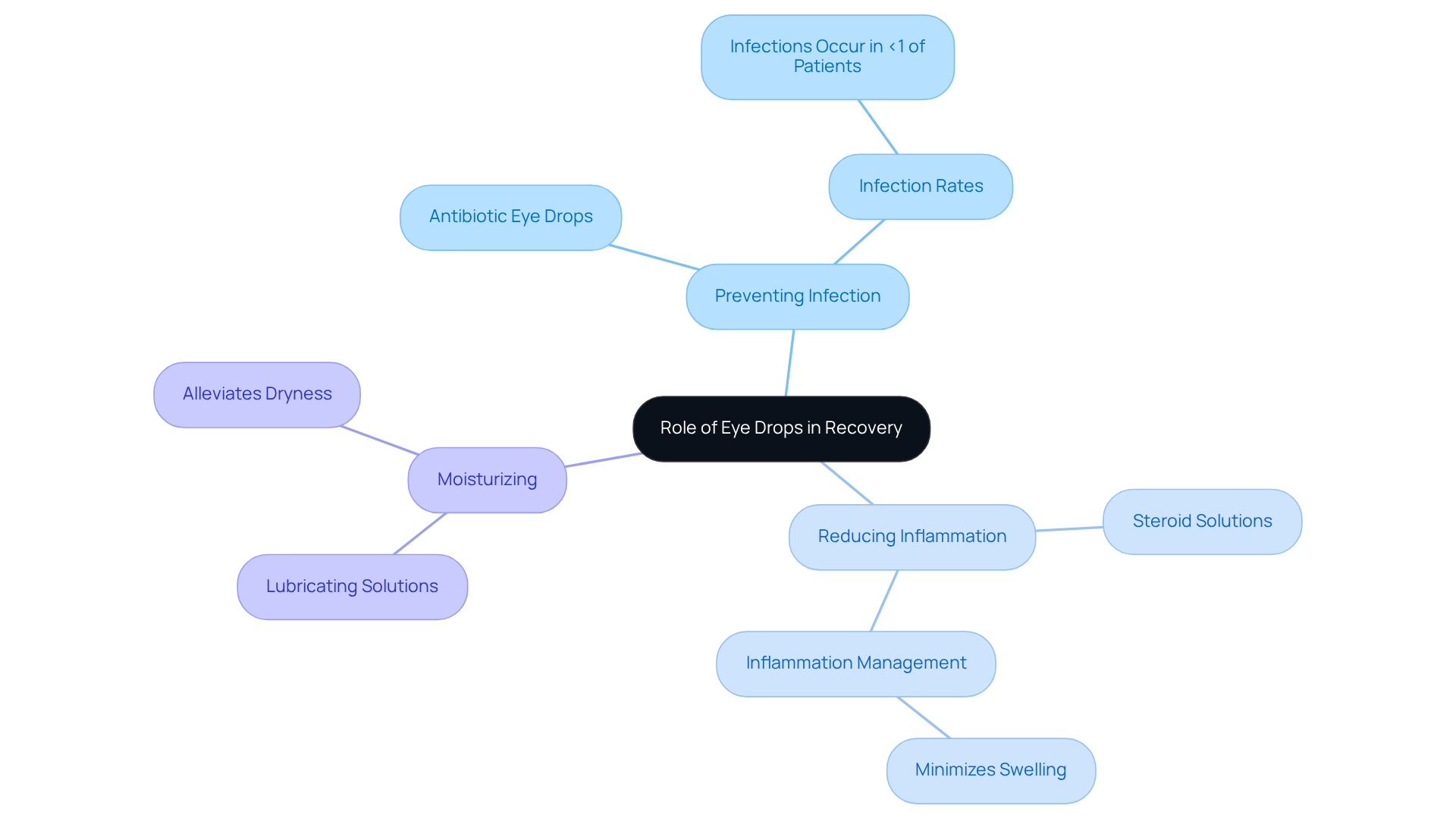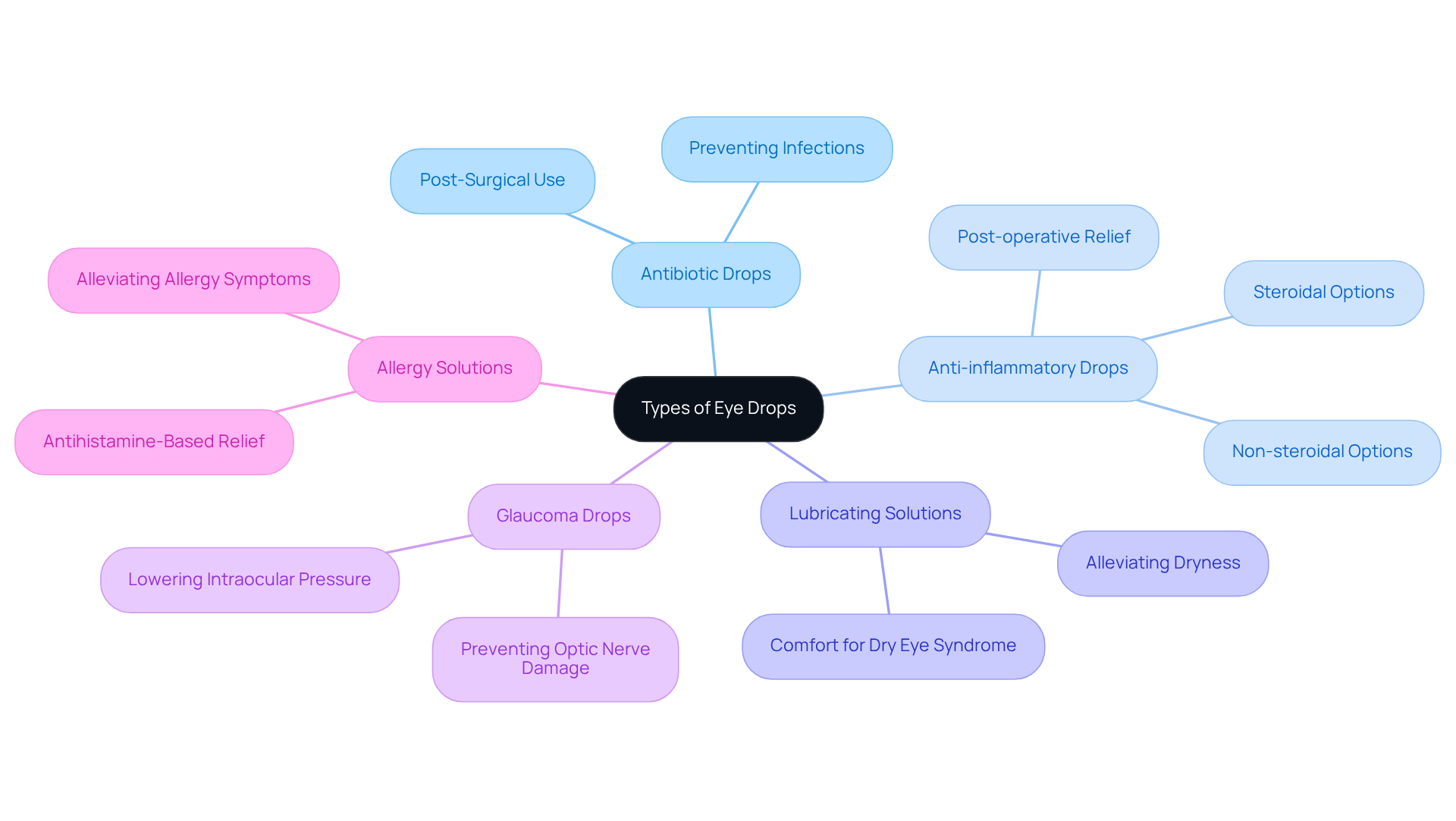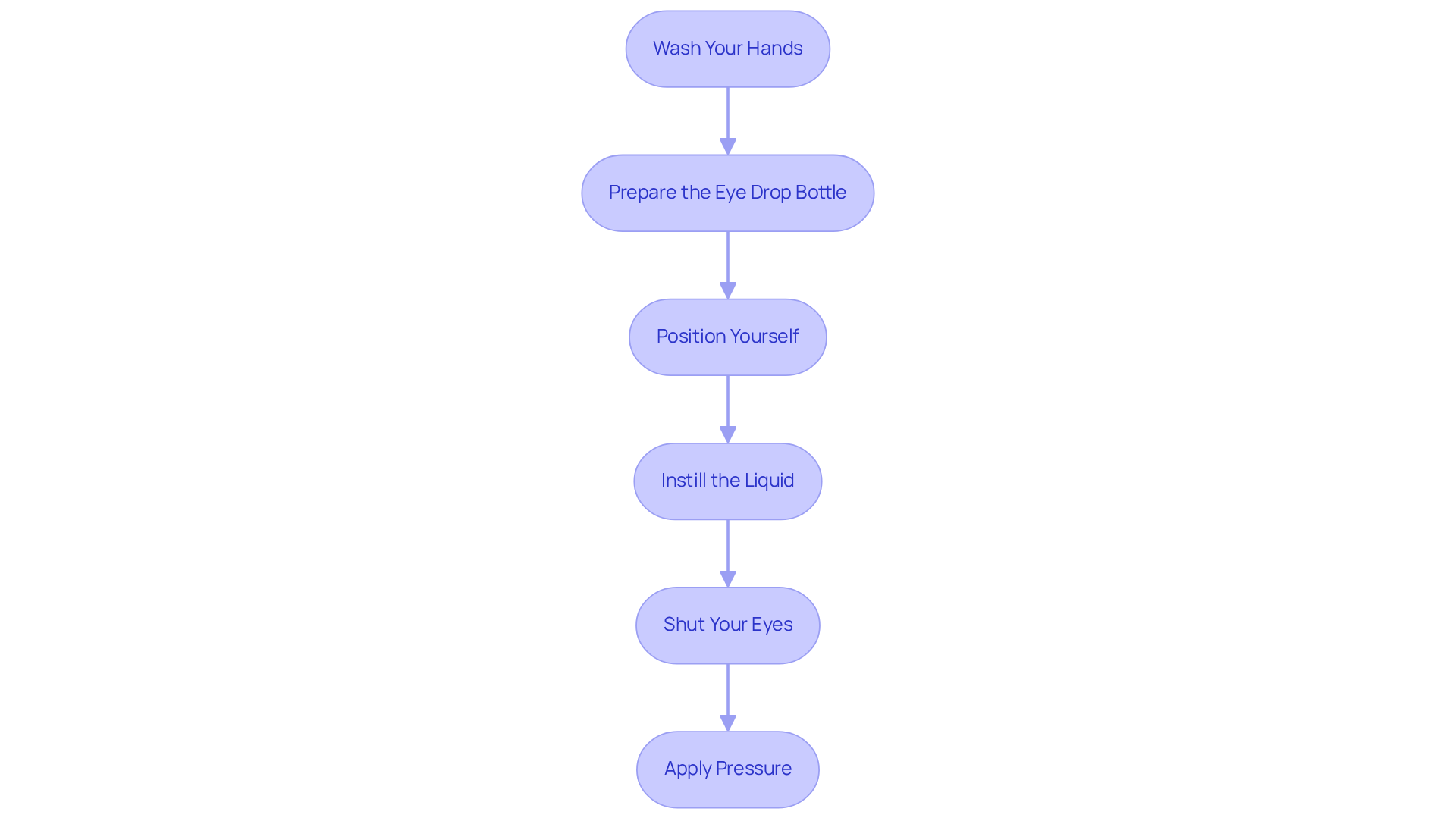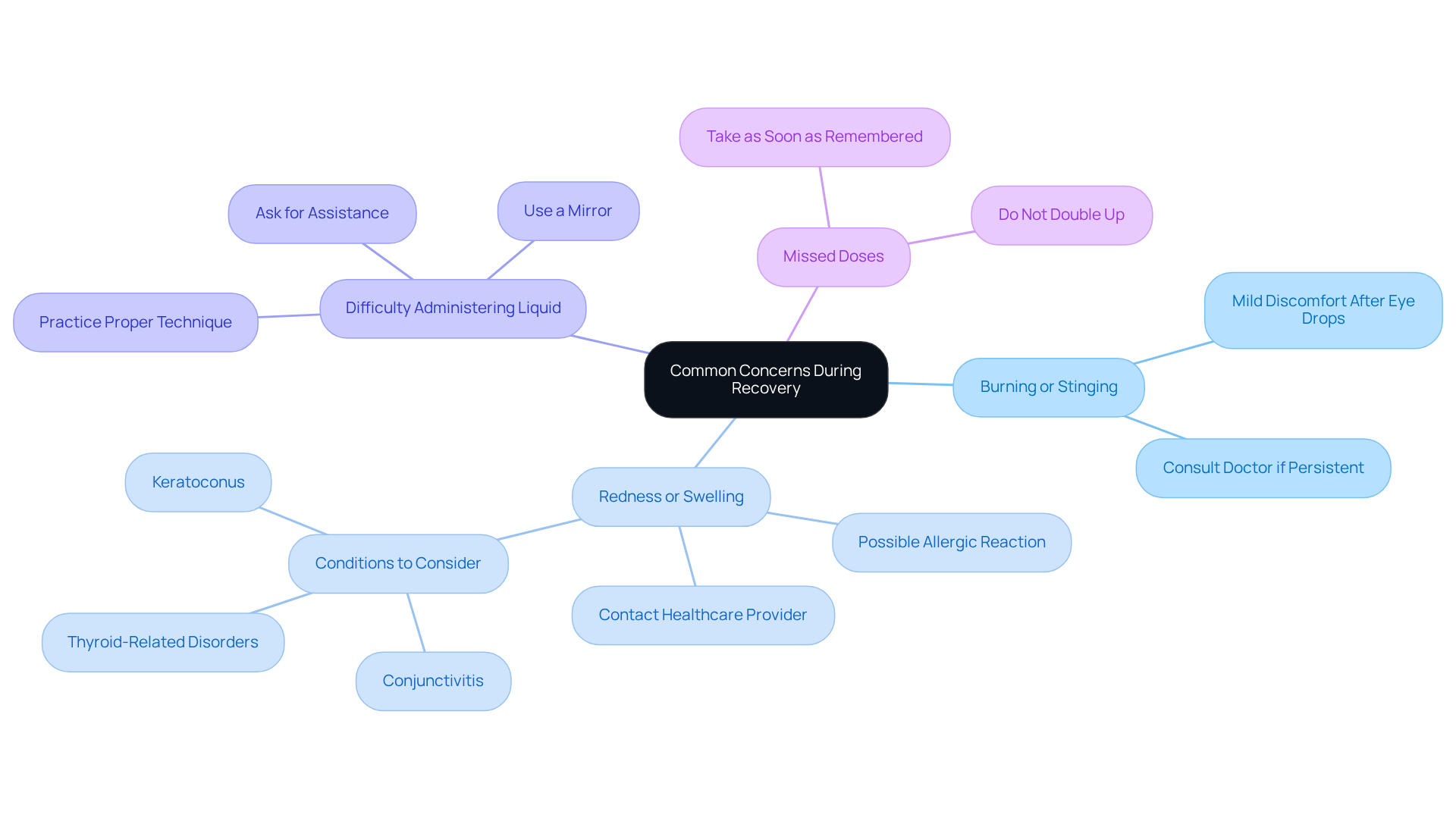Posted by: Northwest Eye in General on August 23, 2025
Overview
This article highlights essential practices for administering eye drops, emphasizing their vital role in recovery from eye surgeries and the management of chronic conditions. We understand that navigating these processes can be challenging, and it’s crucial to approach them with care. Proper administration techniques and adherence to prescribed treatments are not just recommendations; they are key to improving recovery outcomes and reducing the risks of complications. When patients follow best practices, they often experience a smoother recovery journey. We are here to help you through this process, ensuring that you feel supported every step of the way.
Introduction
The importance of proper eye drop administration cannot be overstated, especially when recovering from eye surgeries like cataract operations. We understand that this process can feel overwhelming. Eye drops are not just a vital component in preventing infections and reducing inflammation; they also play a crucial role in managing chronic conditions such as glaucoma and dry eye syndrome.
However, it’s common to feel challenged when applying these solutions effectively, which can lead to concerns about your healing process. How can you ensure that these essential medications are administered correctly? By doing so, you can maximize their benefits and facilitate a smooth recovery. We are here to help you through this process.
Understand the Role of Eye Drops in Recovery
Eye solutions are crucial for your healing journey after eye operations, particularly cataract procedures, and have significant ophthalmic use in managing long-term conditions like glaucoma and dry eye syndrome. Their diverse purposes include:
- Preventing Infection: We understand that the fear of infection can be daunting. That’s why antibiotic eye drops are routinely prescribed after surgery. When proper protocols are followed, infections occur in less than 1% of patients, making this proactive approach crucial for your recovery.
- Reducing Inflammation: It’s common to feel concerned about swelling after surgery. Steroid solutions are essential for minimizing inflammation, helping to ensure a smoother healing process.
- Moisturizing: Dryness can be uncomfortable, but lubricating solutions are here to help. They alleviate discomfort and keep your eye hydrated during the healing phase.
Blurred vision can be a common experience following cataract surgery, often due to uncorrected refractive errors or dry eyes. Recent studies show that about 88% of patients who undergo cataract surgery receive eye medications, underscoring their importance in post-operative care. We encourage you to follow the recommended eye medication routine, as it is essential for optimal healing and long-term eye health.
Beyond recovery, the ophthalmic use of eye solutions is crucial for managing chronic issues like glaucoma and dry eye syndrome. Consistent application of the recommended solutions can help manage intraocular pressure and relieve dryness, significantly reducing the risk of vision loss. Understanding the importance of these medications empowers you to adhere to your treatment plan, ensuring better outcomes and an enhanced quality of life. We are here to help you through this process.

Explore Different Types of Eye Drops and Their Uses
A range of eye solutions designed for ophthalmic use is available, with each formulation thoughtfully created to effectively address specific eye conditions. We understand that navigating eye health can be overwhelming, so here are some common types of solutions that may help you:
-
Antibiotic Drops: These drops are crucial for preventing or treating infections, especially after surgical procedures. Research indicates that applying antibiotic solutions post-surgery significantly reduces the risk of infections, ultimately enhancing recovery outcomes. In fact, a recent study suggests that the global ocular solution market is anticipated to expand at a CAGR of 5.5% from 2023 to 2030, driven by the rising incidence of eye disorders and the need for effective treatment alternatives.
-
Anti-inflammatory Drops: This category includes both steroidal and non-steroidal options designed to alleviate inflammation and pain, providing essential relief for those experiencing discomfort. An eye care expert once shared, “Anti-inflammatory solutions are essential for controlling post-operative discomfort and promoting a more seamless recovery process.”
-
Lubricating Solutions: Often referred to as artificial tears, these solutions are crafted to alleviate dryness and irritation, making them essential for individuals dealing with dry eye syndrome. As the occurrence of dry eye syndrome increases, the demand for lubricating solutions continues to rise, capturing a substantial portion of the market.
-
Glaucoma Drops: These medications are specifically designed to lower intraocular pressure, preventing potential damage to the optic nerve, which is critical for maintaining vision. The market for glaucoma medications is expanding as awareness of this condition grows among the elderly population.
-
Allergy Solutions: Antihistamine-based solutions help alleviate symptoms associated with allergic reactions affecting the eyes, providing much-needed relief for allergy sufferers. With the increasing prevalence of allergies, the demand for these solutions is also on the rise.
Comprehending the unique functions of these eye solutions is crucial for their ophthalmic use, which promotes optimal eye health and recovery. We recognize that it’s common to feel uncertain about the application of these solutions, and being aware of common pitfalls, such as incorrect application techniques, can significantly impact their effectiveness. Anecdotal evidence suggests that patients who follow proper administration guidelines experience significantly better outcomes. Remember, we are here to help you through this process.

Follow Best Practices for Administering Eye Drops
Administering eye solutions correctly is essential for their effectiveness. We understand that this process can feel a bit daunting, but following these best practices can help you feel more confident:
- Wash Your Hands: Always start by washing your hands to prevent contamination. This simple step is crucial for your safety.
- Prepare the Eye Drop Bottle: Shake the bottle gently if required and remove the cap without touching the dropper tip. This helps ensure that the solution remains clean and effective.
- Position Yourself: Tilt your head back slightly and pull down your lower eyelid to create a pocket. This will make it easier to receive the drops.
- Instill the Liquid: Hold the bottle above the eye, squeeze gently to release one bead into the pocket, and avoid touching the eye with the dispenser. We know it can be tricky, but take your time.
- Shut Your Eyes: After applying the solution, gently shut your eyes for a few minutes to permit absorption. Avoid blinking or squeezing your eyes shut; this allows the medication to work effectively.
- Apply Pressure: If suggested, apply gentle pressure to the inner corner of your eye to prevent the liquid from draining away too quickly. This can help maximize the treatment’s effectiveness.
By following these steps, you can significantly enhance the effectiveness of your treatment. Remember, we are here to help you through this process, and it’s common to have questions or concerns. Your comfort and well-being are our top priorities.

Address Common Concerns and Complications During Recovery
During recovery, we understand that you may encounter various concerns related to the ophthalmic use of medications and overall healing. Here are some common issues and how to address them:
- Burning or Stinging: It’s common to experience mild discomfort after applying eye drops. If this sensation persists, please consult your doctor for guidance.
- Redness or Swelling: If you notice increased redness or swelling, it may indicate an allergic reaction, infection, or conditions such as conjunctivitis, which can result in sore, red vision. Other possible reasons for redness in the eyes include dry surface condition, keratoconus, and thyroid-related disorders. We encourage you to contact your healthcare provider immediately.
- Difficulty Administering Liquid: Many patients find it challenging to get the solution in their eyes. Consider using a mirror or asking for assistance if needed. Practicing proper eye medication technique, such as instilling solutions into the lower eyelid pocket without touching the eye, can also enhance success rates.
- Missed Doses: If you forget a dose, take it as soon as you remember unless it’s close to the time for your next dose. Remember, do not double up.
Being aware of these potential complications, including symptoms like redness that may arise from underlying conditions, and knowing how to address them can help ensure a smoother recovery process. It is crucial for achieving optimal healing and visual outcomes to follow your ophthalmologist’s instructions regarding the ophthalmic use of eye drops. We are here to help you through this process.

Conclusion
Understanding the proper use of eye drops is essential for achieving optimal eye health and recovery, especially after surgical procedures. We know that these medications play a vital role in preventing infections, reducing inflammation, and managing chronic conditions such as glaucoma and dry eye syndrome. By adhering to a consistent eye drop regimen, you can significantly enhance your healing process and maintain long-term eye health.
Key insights from this article highlight the importance of various types of eye drops, including:
- Antibiotic solutions
- Anti-inflammatory solutions
- Lubricating solutions
- Glaucoma solutions
- Allergy solutions
Each category serves a unique purpose, and following best practices for administration is crucial for maximizing their effectiveness. Simple steps, such as washing your hands and correctly positioning the eye drop bottle, can make a substantial difference in treatment outcomes.
In conclusion, the significance of eye drops in both recovery and ongoing eye care cannot be overstated. It’s common to feel overwhelmed, but individuals are encouraged to educate themselves on the proper techniques for administering eye drops and to remain vigilant about potential complications during recovery. By doing so, you can empower yourself to take control of your eye health, ensuring a smoother recovery and a brighter future for your vision.
Frequently Asked Questions
What is the role of eye drops in recovery after eye surgery?
Eye drops are crucial for healing after eye operations, particularly cataract procedures. They help prevent infection, reduce inflammation, and keep the eye moisturized during the recovery phase.
How do eye drops prevent infections after surgery?
Antibiotic eye drops are routinely prescribed after surgery to prevent infections. When proper protocols are followed, infections occur in less than 1% of patients, highlighting the importance of this proactive approach.
What type of eye drops are used to reduce inflammation?
Steroid solutions are used to minimize inflammation after surgery, aiding in a smoother healing process.
How do lubricating eye drops help during recovery?
Lubricating solutions help alleviate discomfort from dryness and keep the eye hydrated during the healing phase.
Is blurred vision common after cataract surgery?
Yes, blurred vision can be common after cataract surgery, often due to uncorrected refractive errors or dry eyes.
How prevalent is the use of eye medications after cataract surgery?
Recent studies show that about 88% of patients who undergo cataract surgery receive eye medications, indicating their importance in post-operative care.
Why is it important to follow the recommended eye medication routine?
Following the recommended eye medication routine is essential for optimal healing and long-term eye health.
What chronic conditions can be managed with eye solutions?
Eye solutions are crucial for managing chronic conditions like glaucoma and dry eye syndrome.
How do eye drops help with glaucoma?
Consistent application of recommended solutions can help manage intraocular pressure in patients with glaucoma.
What benefits do eye drops provide for dry eye syndrome?
Eye drops relieve dryness, significantly reducing discomfort and improving the quality of life for individuals with dry eye syndrome.






